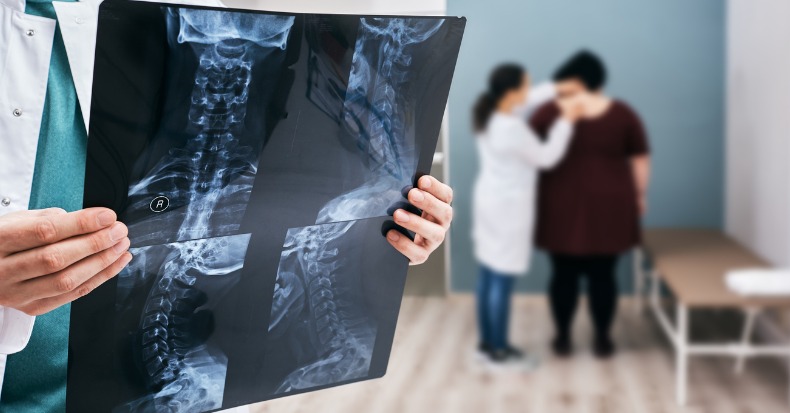Whiplash is most commonly associated with the rapid, uncontrolled movement of the head as it whips back and forth during a motor vehicle collision. Though different types of injuries are associated with rear vs. front vs. side collisions, the net result is similar: the neck hurts! This month, we will look at several “myths” or untruths associated with the cause of whiplash or WAD, whiplash associated disorders.
MYTH #1: MEN ARE MORE VULNERABLE TO INJURY BECAUSE OF THEIR GREATER NECK MUSCLE MASS. FACT: This is exactly the opposite! Women are more vulnerable because they have LESS muscle mass, and hence, less tissue stopping the neck from going through a greater range of motion during the “crack the whip” process. Woman with long, slender necks are especially more vulnerable. They also take longer to recover and are more likely to suffer permanent residual problems long after their case settles.
MYTH #2: YOU CAN’T HAVE A CONCUSSION UNLESS YOU HIT YOUR HEAD. This seems logical as most concussions occur from direct head trauma. However, during the whiplash process, the brain—which is suspended by ligament-like structures inside the skull, bathed in a liquid—can literally smash into the inside wall of the skull resulting in concussion just from the whipping action, without hitting anything. Permanent residuals such as memory problems, articulating thoughts, staying on task, and more can result. This is often called “post-concussive syndrome” or “mild traumatic brain injury.”
MYTH #3: NEGATIVE X-RAYS MEANS NO INJURY. Often, in the ER after a motor vehicle collision, x-rays are taken and read by the radiologist as “…essentially normal.” This can be confused as meaning, “…then there was no injury.” X-rays only show the bones in the neck and head region, not the muscles, tendons, ligaments or nerves. MRI (magnetic resonant imaging) shows more of these “soft tissues,” not just bone. But, due to the high costs of MRI, x-rays are performed first, and only later, if symptoms warrant it, is an MRI ordered. Soft tissue injury to the ligaments (the tissues that strongly hold bone to bone) can be assessed when we take flexion / extension (or bending forwards and backwards) x-rays, but many times these are not ordered in the ER.
MYTH #4: REST AND TIME ALONE WILL HEAL WHIPLASH. Though time for healing plays a role in recovery following all injuries, many patients find this approach fails and their pain persists. In fact, studies suggest that mobilization and manipulation performed as soon as possible after a whiplash injury yields significantly better outcomes than wearing a cervical collar and not moving the neck. Whiplash injuries, when not properly treated, often results in permanent loss of motion, pain, headache, and more. The days of rest and time only should be replaced by the sports medicine model of hot/cold packs, modalities such as interferential, pulsed magnetic stimulation, light or laser therapy, manipulation, massage, traction, and guided exercise. Not wait and watch.
Tune in next month for addition myths about whiplash as there are MANY! Rest assured that prompt chiropractic care is the best approach for treatment of the whiplash injured patient.
Don’t miss the next article, click here for part 2.
